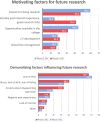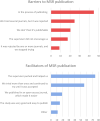Perceptions and Experiences of Pursuing Research Among Medical Students in Problem-Based Learning Curriculum: A Cross-Sectional Study from Qatar
- PMID: 38268725
- PMCID: PMC10807392
- DOI: 10.1177/23821205241227327
Perceptions and Experiences of Pursuing Research Among Medical Students in Problem-Based Learning Curriculum: A Cross-Sectional Study from Qatar
Abstract
Objectives: Early introduction to research prepares medical students for the practice of evidence-based medicine. Few studies have examined the experiences of research among medical students in the Arab region. This study assesses medical students' experiences in pursuing research at the national College of Medicine (CMED) in the state of Qatar.
Methods: This cross-sectional study was conducted using an online questionnaire distributed through Google Forms. The inclusion criteria called for students over 18 years old enrolled in the college in Years 2 to 6 (pre-clinical and clinical phases) during the spring semester of 2022. The questionnaire included 5 sections with multiple-choice questions and 5-point Likert-scale questions. The questionnaire was validated using esperts review and by piloting it on 10% of the eligible students. STATA 17.0 was used to perform the statistical analysis, which involved a logistic regression and Mann-Whitney U test.
Results: The study had 179 student participants (over half of the eligible group). Half were in the preclinical phase, and half were in the clinical phase. Approximately half had published at least 1 paper. For voluntary research, the main motivators were passion and positive past experiences, while the main demoralizer was inadequate time. For mandatory medical-student research, supervisor help was the main facilitator, and an academic load leaving insufficient time for research was the main barrier. The factors positively influencing voluntary research participation were being older, being male, studying in a more advanced program phase, and having a lower score for negative attitudes toward research. The main limitation of the study was the inclusion of only 1 medical school with 1 type of curriculum.
Conclusions: Our findings suggest that better research experience can be ensured by providing space, time, and proper academic and moral support to students. The authors believe that doing so will indirectly positively affect the future translation of skills in evidence-based medicine into clinical practice.
Keywords: medical education; motivators; problem-based learning curriculum; pursuing research; undergraduate.
© The Author(s) 2024.
Conflict of interest statement
The authors declared no potential conflicts of interest with respect to the research, authorship, and/or publication of this article.
Figures






Similar articles
-
Recovery schools for improving behavioral and academic outcomes among students in recovery from substance use disorders: a systematic review.Campbell Syst Rev. 2018 Oct 4;14(1):1-86. doi: 10.4073/csr.2018.9. eCollection 2018. Campbell Syst Rev. 2018. PMID: 37131375 Free PMC article.
-
Student and educator experiences of maternal-child simulation-based learning: a systematic review of qualitative evidence protocol.JBI Database System Rev Implement Rep. 2015 Jan;13(1):14-26. doi: 10.11124/jbisrir-2015-1694. JBI Database System Rev Implement Rep. 2015. PMID: 26447004
-
EXPLORING REASONS THAT U.S. MD-PHD STUDENTS ENTER AND LEAVE THEIR DUAL-DEGREE PROGRAMS.Int J Dr Stud. 2020;15:461-483. doi: 10.28945/4622. Int J Dr Stud. 2020. PMID: 33815015 Free PMC article.
-
Impact of summer programmes on the outcomes of disadvantaged or 'at risk' young people: A systematic review.Campbell Syst Rev. 2024 Jun 13;20(2):e1406. doi: 10.1002/cl2.1406. eCollection 2024 Jun. Campbell Syst Rev. 2024. PMID: 38873396 Free PMC article. Review.
-
The effects of flipped classrooms to improve learning outcomes in undergraduate health professional education: A systematic review.Campbell Syst Rev. 2023 Jul 7;19(3):e1339. doi: 10.1002/cl2.1339. eCollection 2023 Sep. Campbell Syst Rev. 2023. PMID: 37425620 Free PMC article. Review.
Cited by
-
Why Saudi Respiratory Therapists Struggle with Research: An Evidence-Based Analysis.Adv Med Educ Pract. 2025 Jul 22;16:1259-1267. doi: 10.2147/AMEP.S520760. eCollection 2025. Adv Med Educ Pract. 2025. PMID: 40726959 Free PMC article.
References
LinkOut - more resources
Full Text Sources
Miscellaneous

